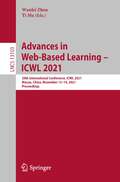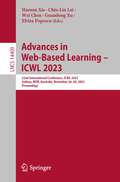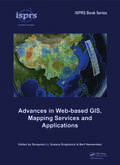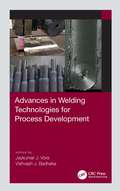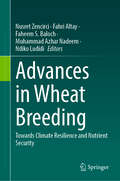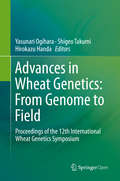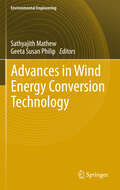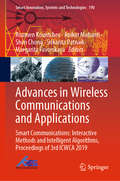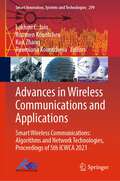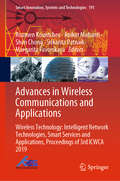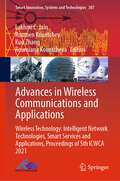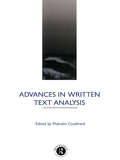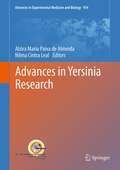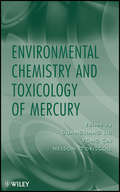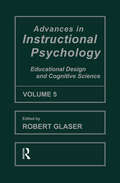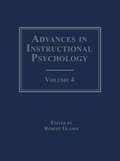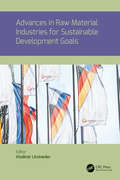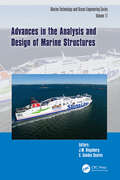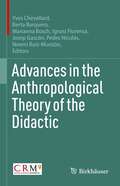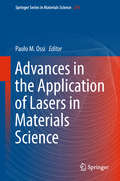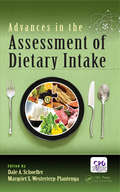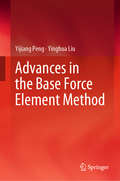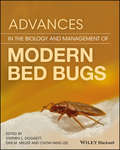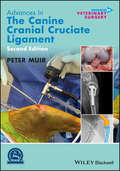- Table View
- List View
Advances in Web-Based Learning – ICWL 2021: 20th International Conference, ICWL 2021, Macau, China, November 13–14, 2021, Proceedings (Lecture Notes in Computer Science #13103)
by Wanlei Zhou Yi MuThis book constitutes the proceedings of the 20th International Conference on Advances in Web-Based Learning, ICWL 2021, which was held in Macau, China, in November 2021. The papers included in this volume deal with multiple topics, from algorithms to systems and applications and are organized in 3 tracks: Online learning methodologies, trust, and analysis; Online learning environment with tools; Online learning privacy issues and special tools.
Advances in Web-Based Learning – ICWL 2023: 22nd International Conference, ICWL 2023, Sydney, NSW, Australia, November 26–28, 2023, Proceedings (Lecture Notes in Computer Science #14409)
by Wei Chen Guandong Xu Elvira Popescu Haoran Xie Chiu-Lin LaiThis book constitutes the proceedings of the International Conference on Web-Based Learning, ICWL 2023, in Sydney, NSW, Australia, in November 2023.The 9 full papers together with 7 short papers included in this volume were carefully reviewed and selected from 23 submissions. The conference focuses on subjects such as Semantic Web for E-Learning, through Learning Analytics, Computer-Supported Collaborative Learning, Assessment, Pedagogical Issues, E-learning Platforms, and Tools, to Mobile Learning.
Advances in Web-based GIS, Mapping Services and Applications (ISSN)
by Songnian Li Suzana Dragićević Bert VeenendaalAdvances in Web-based GIS, Mapping Services and Applications is published as part of ISPRS WG IV/5 effort, and aims at presenting (1) Recent technological advancements, e.g., new developments under Web 2.0, map mashups, neogeography and the like; (2) Balanced theoretical discussions and technical implementations; (3) Commentary on the current stage
Advances in Welding Technologies for Process Development
by Jaykumar Vora Vishvesh J. BadhekaWithin manufacturing, welding is by far the most widely used fabrication method used for production, leading to a rise in research and development activities pertaining to the welding and joining of different, similar, and dissimilar combinations of the metals. This book addresses recent advances in various welding processes across the domain, including arc welding and solid-state welding process, as well as experimental processes. The content is structured to update readers about the working principle, predicaments in existing process, innovations to overcome these problems, and direct industrial and practical applications. Key Features: Describes recent developments in welding technology, engineering, and science Discusses advanced computational techniques for procedure development Reviews recent trends of implementing DOE and meta-heuristics optimization techniques for setting accurate parameters Addresses related theoretical, practical, and industrial aspects Includes all the aspects of welding, such as arc welding, solid state welding, and weld overlay
Advances in Wheat Breeding: Towards Climate Resilience and Nutrient Security
by Nusret Zencirci Faheem S. Baloch Fahri Altay Muhammad Azhar Nadeem Ndiko LudidiThis edited book addresses the introduction to wheat, advancements in breeding, the contribution of biotechnological approaches, the development of climate-resilient wheat cultivars, and biofortification efforts to create nutrient-rich wheat cultivars.The world faces simultaneous challenges of a growing population and climate change. It is anticipated that the world population will exceed 9 billion by 2050. Meanwhile, climate change significantly impacts agriculture through uneven patterns, expected to worsen in the coming years, resulting in substantial losses due to biotic and abiotic stresses. Wheat, a staple food for millions worldwide, requires more studies to develop climate-resilient cultivars with improved nutritional content. Given these considerations, it is crucial to understand the activities conducted for wheat breeding and address the current gap to ensure an ample food supply for future generations.This book is beneficial for researchers, teachers, agriculturists, biologists, climate change scientists, and organizations involved in wheat breeding. It also serves as a valuable resource for undergraduate, master, and PhD students interested in wheat.
Advances in Wheat Genetics: Proceedings of the 12th International Wheat Genetics Symposium
by Yasunari Ogihara Shigeo Takumi Hirokazu HandaThis proceedings is a collection of 46 selected papers that were presented at the 12th International Wheat Genetics Symposium (IWGS). Since the launch of the wheat genome sequencing project in 2005, the arrival of draft genome sequences has marked a new era in wheat genetics and genomics, catalyzing rapid advancement in the field. This book provides a comprehensive review of the forefront of wheat research, across various important topics such as germplasm and genetic diversity, cytogenetics and allopolyploid evolution, genome sequencing, structural and functional genomics, gene function and molecular biology, biotic stress, abiotic stress, grain quality, and classical and molecular breeding. Following an introduction, 9 parts of the book are dedicated to each of these topics. A final, 11th part entitled "Toward Sustainable Wheat Production" contains 7 excellent papers that were presented in the 12th IWGS Special Session supported by the OECD. With rapid population growth and radical climate changes, the world faces a global food crisis and is in need of another Green Revolution to boost yields of wheat and other widely grown staple crops. Although this book focuses on wheat, many of the newly developed techniques and results presented here can be applied to other plant species with large and complex genomes. As such, this volume is highly recommended for all students and researchers in wheat sciences and related plant sciences and for those who are interested in stable food production and food security.
Advances in Wind Energy Conversion Technology (Environmental Science and Engineering)
by Geeta Susan Philip Mathew SathyajithWith an annual growth rate of over 35%, wind is the fastest growing energy source in the world today. As a result of intensive research and developmental efforts, the technology of generating energy from wind has significantly changed during the past five years. The book brings together all the latest aspects of wind energy conversion technology - right from the wind resource analysis to grid integration of the wind generated electricity. The chapters are contributed by academic and industrial experts having vast experience in these areas. Each chapter begins with an introduction explaining the current status of the technology and proceeds further to the advanced lever to cater for the needs of readers from different subject backgrounds. Extensive bibliography/references appended to each chapter give further guidance to the interested readers.
Advances in Wireless Communications and Applications: Smart Communications: Interactive Methods and Intelligent Algorithms, Proceedings of 3rd ICWCA 2019 (Smart Innovation, Systems and Technologies #190)
by Srikanta Patnaik Margarita Favorskaya Roumen Kountchev Aniket Mahanti Shen ChongThis book features selected papers presented at the 3rd International Conference on Wireless Communications and Applications (ICWCA 2019), held at Hainan University, China. Focusing on applications of the latest smart theories and approaches, and recent advances in the field, it covers topics such as OFDM and multi-carrier techniques; smart antenna and space-time signal processing; MIMO, multi-user MIMO, and massive MIMO; modulation, coding, and diversity techniques; dynamic spectrum access and cognitive radio; interference management and radio resource allocation; equalization techniques; synchronization, estimation, and detection techniques; and wireless multiple access (e.g. CDMA, OFDMA, NOMA, ).
Advances in Wireless Communications and Applications: Smart Wireless Communications: Algorithms and Network Technologies, Proceedings of 5th ICWCA 2021 (Smart Innovation, Systems and Technologies #299)
by Lakhmi C. Jain Roumen Kountchev Kun Zhang Roumiana KountchevaThis book features selected papers presented at the 5th International Conference on Wireless Communications and Applications (ICWCA 2021), held at Hainan University, China. The book will focus on the presentation of the newest trends and achievements in the development of intelligent algorithms and network technologies in smart communications, with application in underwater communications, IoT-based marine surface communications as well as state-of-the-art real-time precise location technologies, Wi-Fi/Bluetooth locationing, array signal processing, and many others.
Advances in Wireless Communications and Applications: Wireless Technology: Intelligent Network Technologies, Smart Services and Applications, Proceedings of 3rd ICWCA 2019 (Smart Innovation, Systems and Technologies #191)
by Srikanta Patnaik Margarita Favorskaya Roumen Kountchev Aniket Mahanti Shen ChongThis book gathers selected papers presented at the 3rd International Conference on Wireless Communications and Applications (ICWCA 2019), held at Hainan University, China. It covers up-to-date smart theories and approaches, as reflected in contemporary technical achievements in the area. The topics covered include: software-defined networking (SDN) and network function virtualization (NFV), future data center networks, 5G/6G mobile networks, QoS/QoE support in future networks, future Internet of things (IoT) networks, network fault management and service availability, and many others.
Advances in Wireless Communications and Applications: Wireless Technology: Intelligent Network Technologies, Smart Services and Applications, Proceedings of 5th ICWCA 2021 (Smart Innovation, Systems and Technologies #307)
by Lakhmi C. Jain Roumen Kountchev Kun Zhang Roumiana KountchevaThis book features selected papers presented at the 5th International Conference on Wireless Communications and Applications (ICWCA 2021), held at Hainan University, China. The book will focus on the presentation of the newest trends and achievements in the development of intelligent algorithms and network technologies in smart communications, with application in underwater communications, IoT-based marine surface communications as well as state-of-the-art real-time precise location technologies, WiFi/Bluetooth locationing, array signal processing and many others.
Advances in Wireless Sensor Networks: The 8th China Conference, CWSN 2014, Xi'an, China, October 31--November 2, 2014. Revised Selected Papers (Communications in Computer and Information Science #501)
by Wei Wang Limin Sun Huadong Ma Dingyi Fang Jinping NiuThis book constitutes the refereed proceedings of the 8th China Conference of Wireless Sensor Networks, held in Xi'an, China, in October/November 2014. The 64 revised full papers were carefully reviewed and selected from 365 submissions. The papers are organized in topical sections on power control and management; network architecture and deployment; positioning and location-based services in wireless sensor networks; security and privacy; wireless communication systems and protocols; routing algorithm and transport protocols in wireless sensor networks; wireless communication protocols and sensor data quality, integrity and trustworthiness; Internet of Things; wireless mobile network architecture, in-vehicle network; indoor positioning and location-based services; applications of wireless sensor networks.
Advances in Written Text Analysis
by Malcolm CoulthardThis work provides an overview of a wide range of approaches to written text analysis. It includes both classic and specially commissioned papers by distinguished authors, which share a common linguistic framework. The pieces contain a variety of focuses from the patterning of paragraphs, sections or whole texts to the organization of clauses, individual expressions and single words, as well as a variety of text-types. The examples used range from pure science through social science, academic journals, weekly magazines and newspapers, to literary narratives. This collection forms the basis for an course on written text analysis that should be of interest to advanced undergraduate and postgraduate students.
Advances in Yersinia Research (Advances in Experimental Medicine and Biology #954)
by Alzira Maria de Almeida Nilma Cintra LealThis book is a collection of articles written by prominent scientists who gathered in the city of Recife, Brazil, 23-27 October 2010, celebrating the 10th International Symposium on Yersinia. The event is held every four years in a different country and for the Yersinia 2010, an interesting and updated program covering advances in research in Yersiniae was organized. The major advances achieved over the past four years since the last symposium held in Lexington, USA in 2006 were divided into eight chapters: Epidemiology, Clinical, Diagnostic and Therapeutic aspects; Ecology and Modeling; Genomic/Transcriptomics and Large Scale Population; Immune Response and Vaccine; Pathogenesis and Pathogenicity Factors; Cellular Yersiniology; Bacterial Structure and Metabolism: Roles in Pathogenesis and Bacterial Life Style. The purpose of the book is to extend cutting edge knowledge on Yersinia discussed during the 10th International Symposium.
Advances in environmental chemistry and toxicology of mercury
by Guangliang Liu Yong Cai Nelson O'DriscollThe book that looks at mercury's impact on the planet today Recent research by the EPA has concluded that one in six women of childbearing age have unsafe levels of mercury in their bodies, which puts 630,000 newborn babies each year at risk of neurological impairment. Mercury poses severe risks to the health of animals and ecosystems around the world, and this book provides the essential information that anyone interested in environmental sciences should know about the fundamentals of the entire mercury cycle. Comprised of four parts that present an overview of mercury in the environment, mercury transformations, transport, and bioaccumulation and toxicology, each chapter of Environmental Chemistry and Toxicology of Mercury includes the basic concepts of the targeted subject, a critical review of that subject, and the future research needs. This book explains the environmental behavior and toxicological effects of mercury on humans and other organisms, and provides a baseline for what is known and what uncertainties remain in respect to mercury cycling. The chapters focus on the fundamental science underlying the environmental chemistry and fate of mercury. This work will be invaluable to a wide range of policy experts, environmental scientists, and other people requiring a comprehensive source for the state of the science in this field.
Advances in instructional Psychology, Volume 5: Educational Design and Cognitive Science (Advances In Instructional Psychology Ser.)
by Robert GlaserInvestigators have moved back and forth between design efforts and basic studies in cognition to improve both application and fundamental knowledge. This volume's theme is this interaction between practice and science with the opportunity for reflecting on findings in order to understand them and suggesting improved forms of application and their underlying explanation. This is seen in various arenas including theory-based computer-assisted instruction for teaching mathematics, the design of communities of learning in elementary schools, teaching in the context of problem-solving situations and reasoning with models, self-explanation as a highly effective learning activity, conceptual change in medical training and health education, and workplace training in electronic troubleshooting. The results of extensive long-term experience and analysis in each of these areas are insightfully reported by the well-known contributors to this volume. Special features of this fifth edition include: * The work of eminent cognitive scientists in the design and evaluation of educational and training environments to increase current understanding of learning and development, as this understanding is applied to innovative instructional programs and teaching methods. * A description of learning theory and principles as well as implications and examples on research and development on educational application. * A presentation on the 10-year change in perspective on research and development in problem solving environments that invite inquiry about academic information and skills in the context of instruction of elementary school children. * An innovative approach to math and science instruction in which teaching is oriented around constructing, evaluating, and revising models. * An examination of the process of self-explaining, which involves explaining to one's self in an attempt to make sense of a new situation. * A description of a long-term program of cognitive task analysis and instructional design on problem solving in the operation of complex equipment. * An investigation on the acquisition of clinical reasoning skills and the understanding of biomedical concepts in both professional medicine and the health practices of the lay population.
Advances in instructional Psychology: Volume 4 (Advances in Instructional Psychology Series)
by Robert GlaserThe contributors to this volume address reasoning and problem solving as fundamental to learning and teaching and to modern literacy. The research on expertise and the development of competence makes it clear that structures of knowledge and cognitive process should be tightly linked throughout education to attain high levels of ability. The longstanding pedagogical assumption that the attainment of useful knowledge proceeds from lower level learning based on the practice of fundamental skills that demand little thought, to higher level competence in which problem solving finally plays an increasing role, is no longer tenable. It is now clear that thinking is not an outcome of basic learning, but is part of the basic acquisition of knowledge and skill. In learning to read, for example, decoding the printed word and understanding simple texts is an act of problem solving, requiring inference and elaboration by the reader. The prevalence of reasoning with information at all levels makes the details of its involvement a fundamental influence on learning and instruction -- a recurring theme in each of the chapters. A rich variety of topics is addressed including: *an analysis of the components of teaching competence *the evolution of a learner's mathematical understanding *the use of causal models for generating scientific explanations *the facilitation of meaningful learning through text illustrations *the competence of children in argumentative interaction that results in conceptual change.
Advances in raw material industries for sustainable development goals: PROCEEDINGS OF THE XII RUSSIAN-GERMAN RAW MATERIALS CONFERENCE (SAINT-PETERSBURG, RUSSIA, 27-29 NOVEMBER 2019)
by Vladimir Litvinenko"Advances in Raw Material Industries for Sustainable Development Goals" presents the results of joint scientific research conducted in the context of the Russian-German Raw Materials Forum. Today Russia and Germany are exploring various forms of cooperation in the field of mining, geology, mineralogy, mechanical engineering and energy. Russia and Germany are equally interested in expanding cooperation and modernizing the economy in terms of sustainable development. The main theme of this article collection is connected with existing business ventures and ideas from both Russia and Germany. In this book the authors regard complex processes in mining industry from various points of view, including: - modern technologies in prospecting, exploration and development of mineral resources- progressive methods of natural and industrial mineral raw materials processing- energy technologies and digital technologies for sustainable development- cutting-edge technologies and innovations in the oil and gas industry. Working with young researchers, supporting their individual professional development and creating conditions for their mobility and scientific cooperation are essential parts of Russian-German Raw Materials Forum founded in Dresden 13 years ago. This collection represents both willingness of young researchers to be involved in large-scale international projects like Russian-German Raw Material Forum and the results of their long and thorough work in the promising areas of cooperation between Russia and Germany.
Advances in the Analysis and Design of Marine Structures: Proceedings of the 9th International Conference on Marine Structures (MARSTRUCT 2023, Gothenburg, Sweden, 3-5 April 2023) (Proceedings in Marine Technology and Ocean Engineering)
by J. W. RingsbergAdvances in the Analysis and Design of Marine Structures is a collection of papers presented at MARSTRUCT 2023, the 9th International Conference on Marine Structures, held in Gothenburg, Sweden, 3-5 April 2023. The conference was organised by the Division of Marine Technology, Department of Mechanics and Maritime Sciences at Chalmers University of Technology, in Gothenburg, Sweden. The MARSTRUCT Conference series deals with Ship and Offshore Structures, addressing topics in the fields of: • Methods and tools for loads and load effects• Methods and tools for strength assessment• Experimental analysis of structures• Materials and fabrication of structures• Methods and tools for structural design and optimization• Structural reliability, safety, and environmental protection The MARSTRUCT conferences series of started in Glasgow, UK in 2007, the second event of the series took place in Lisbon, Portugal in March 2009, the third in Hamburg, Germany in March 2011, the fourth in Espoo, Finland in March 2013, the fifth in Southampton, UK in March 2015, the sixth in Lisbon, Portugal in May 2017, the seventh in Dubrovnik, Croatia in May 2019, and the eighth event in Trondheim, Norway in June 2021. Advances in the Analysis and Design of Marine Structures is essential reading for academics, engineers and all professionals involved in the design of marine and offshore structures. The Proceedings in Marine Technology and Ocean Engineering series is devoted to the publication of proceedings of peer-reviewed international conferences dealing with various aspects of ‘Marine Technology and Ocean Engineering’. The Series includes the proceedings of the following conferences: the International Maritime Association of the Mediterranean (IMAM) Conferences, the Marine Structures (MARSTRUCT) Conferences, the Renewable Energies Offshore (RENEW) Conferences and the Maritime Technology (MARTECH) Conferences. The ‘Marine Technology and Ocean Engineering’ series is also open to new conferences that cover topics on the sustainable exploration and exploitation of marine resources in various fields, such as maritime transport and ports, usage of the ocean including coastal areas, nautical activities, the exploration and exploitation of mineral resources, the protection of the marine environment and its resources, and risk analysis, safety and reliability. The aim of the series is to stimulate advanced education and training through the wide dissemination of the results of scientific research.
Advances in the Anthropological Theory of the Didactic
by Marianna Bosch Yves Chevallard Berta Barquero Ignasi Florensa Pedro Nicolás Noemí Ruiz-Munzón Josep GascónThe book focuses on the latest developments of the Anthropological Theory of the Didactic (ATD) and its links with other approaches in mathematics education. Leading researchers in the ATD and especially its creator, Yves Chevallard, present recent research results, theoretical advances and new methodologies in this approach, concerning critical educational problems at all levels. The book is addressed to researchers in mathematics education and all related fields, to teacher educators and teachers in primary, secondary and tertiary education interested in curriculum issues and research in didactics.The book includes four sections that correspond to four axes of current research in the framework of the ATD. The first one studies the relations between the ATD and other research frameworks. The second section focuses on the crucial role of didactics in teacher education, and the experiences carried out at different instructional levels. The third section addresses the curriculum problem in the historical transition from the classical paradigm of visiting works to the emerging didactic paradigm of questioning the world. The last section is about research in didactics at the university level, with investigations about the analysis of didactic transposition processes and the design and implementation of various instructional formats.
Advances in the Application of Lasers in Materials Science (Springer Series in Materials Science #274)
by Paolo M. OssiThe book covers recent advances and progress in understanding both the fundamental science of lasers interactions in materials science, as well as a special emphasis on emerging applications enabled by the irradiation of materials by pulsed laser systems. The different chapters illustrate how, by careful control of the processing conditions, laser irradiation can result in efficient material synthesis, characterization, and fabrication at various length scales from atomically-thin 2D materials to microstructured periodic surface structures. This book serves as an excellent resource for all who employ lasers in materials science, spanning such different disciplines as photonics, photovoltaics, and sensing, to biomedical applications.
Advances in the Assessment of Dietary Intake.
by Dale A. Schoeller M. WesterterpDiet is a major factor in health and disease. Controlled, long-term studies in humans are impractical, and investigators have utilized long-term epidemiological investigations to study the contributions of diet to the human condition. Such studies, while valuable, have often been limited by contradictory findings; a limitation secondary to systematic errors in traditional self-reported dietary assessment tools that limit the percentage of variances in diseases explained by diet. New approaches are available to help overcome these limitations, and Advances in the Assessment of Dietary Intake is focused on these advances in an effort to provide more accurate dietary data to understand human health. Chapters cover the benefits and limitations of traditional self-report tools; strategies for improving the validity of dietary recall and food recording methods; objective methods to assess food and nutrient intake; assessment of timing and meal patterns using glucose sensors; and physical activity patterns using validated accelerometers. Advances in the Assessment of Dietary Intake describes new avenues to investigate the role of diet in human health and serves as the most up-to-date reference and teaching tool for these methods that will improve the accuracy of dietary assessment and lay the ground work for future studies.
Advances in the Base Force Element Method
by Yijiang Peng Yinghua LiuThis book describes the main concepts of and recent advances in the base forces element method (BFEM). It combines theories, methods, models, numerical results, and an analysis of the BFEM. Each chapter starts with an introduction and derivation of a new mathematical model for the proposed method. Subsequently, the methods are described and numerical examples demonstrating the significance of the proposed method are presented. The closing chapter summarizes the performance and features of the BFEM and describes the prospects for its application. The book is intended for engineers, scientists and graduate students in applied mechanics and applied mathematics, and for all readers interested in numerical computations and simulations.
Advances in the Biology and Management of Modern Bed Bugs
by Stephen L. Doggett Dini M. Miller Chow-Yang LeeThe first comprehensive scholarly treatment of bed bugs since 1966 This book updates and expands on existing material on bed bugs with an emphasis on the worldwide resurgence of both the common bed bug, Cimex lectularius L., and the tropical bed bug, Cimex hemipterus (F.). It incorporates extensive new data from a wide range of basic and applied research, as well as the recently observed medical, legal, and regulatory impacts of bed bugs. Advances in the Biology and Management of Modern Bed Bugs offers new information on the basic science and advice on using applied management strategies and bed bug bioassay techniques. It also presents cutting-edge information on the major impacts that bed bugs have had on the medical, legal, housing and hotel industries across the world, as well as their impacts on public health. Advances in the Biology and Management of Modern Bed Bugs offers chapters that cover the history of bed bugs; their global resurgence; their impact on society; their basic biology; how to manage them; the future of these pests; and more. Provides up-to-date information for the professional pest manager on bed bug biology and management Features contributions from 60 highly experienced and widely recognized experts, with 48 unique chapters A one-stop-source that includes historic, technical, and practical information Serves as a reference book for academic researchers and students alike Advances in the Biology and Management of Modern Bed Bugs is an essential reference for anyone who is impacted by bed bugs or engaged in managing bed bugs, be it in an academic, basic or applied scientific setting, or in a public outreach, or pest management role, worldwide.
Advances in the Canine Cranial Cruciate Ligament
by Peter MuirAdvances in the Canine Cranial Cruciate Ligament, Second Edition presents in-depth, focused, and updated coverage of current knowledge on cruciate ligament rupture, using a multidisciplinary, evidence-based approach. Presents a state-of-the-art summary of the most recent knowledge on this important cause of lameness in dogs Led by a highly respected surgeon and researcher, with chapters written by leading experts in the field Provides an update to the groundbreaking first edition, with six new chapters
